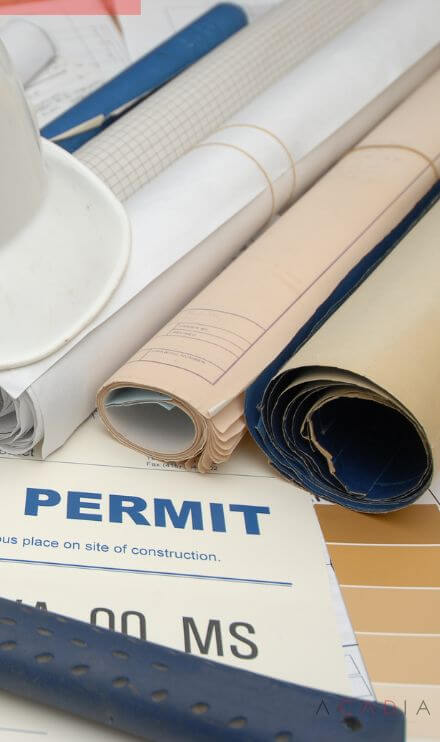Unfortunately, some permit plans are rejected by the city, and become a setback from the construction or renovation process. The upside is that they serve as a valuable feedback mechanism, guiding necessary revisions to align the plans with local building codes, zoning regulations, safety standards, and aesthetic guidelines. Addressing the issues raised in rejection drawings ensures that the proposed project complies with the city’s requirements, promoting safety, structural integrity, and adherence to environmental considerations.
Acadia Drafting will help with successfully revising and resubmitting rejected drawings, maintaining open communication with city authorities, and being proactive in addressing feedback to navigate the challenges posed by rejection drawings effectively.

Upon receiving a rejection for drawing permits, our first step involves comprehensively understanding the specific grounds for the rejection. Subsequently, we meticulously adjust the drawings to comply with building codes, zoning regulations, and safety standards, addressing the concerns highlighted by the city. We then articulate these modifications clearly in a cover letter, which accompanies the resubmission of the revised drawings to the city authorities. Throughout this process, our team maintains transparent communication with the client, ensuring they are well informed about the challenges at hand and the measures being taken to address them.
Throughout the process, we’ll demonstrate patience and persistence as revising and resubmitting permits is time-consuming. By ensuring compliance with regulations and addressing the city’s concerns, you increase your chances of obtaining approval for your drawing permits, allowing your construction or renovation project to move forward smoothly.

Permit drawings can be rejected by the city for several reasons, all of which generally stem from non-compliance with local regulations and standards. One common cause is inaccuracies within the drawings, such as errors in measurements, calculations, or architectural details. These inaccuracies can compromise the safety and integrity of the proposed structure, leading to rejection. Another reason is a lack of clarity in the drawings. If the plans are not presented clearly or are difficult to interpret, city officials may reject them, as it’s crucial for the drawings to convey the intended construction or renovation accurately.
Non-compliance with local building codes, zoning regulations, safety standards, and aesthetic guidelines is a primary factor in rejection. City authorities meticulously review the submitted drawings to ensure they align with these regulations. Any deviations or oversights can lead to rejection. Additionally, failure to consider environmental factors, energy efficiency, or sustainability requirements can also result in rejection, especially in today’s focus on eco-friendly construction practices. Addressing these aspects diligently and accurately in permit drawings is essential to avoid rejection and move forward with the construction or renovation project smoothly.

We're available to answer any questions you may have about city rejection drawings. Here are some common inquiries we get on the issue.
City Rejection Drawings refer to architectural or construction plans that have been submitted to municipal authorities for approval but have been turned down due to various reasons. These reasons can include non-compliance with local building codes, zoning regulations, safety standards, or design guidelines. When drawings are rejected by the city, it indicates that the proposed project does not meet the necessary criteria set forth by the city authorities, requiring revisions and modifications to align with the established regulations. Addressing these issues is crucial to obtaining approval and ensuring that the construction or renovation project adheres to the city’s guidelines and standards.
Yes, it is common for drawings to be rejected during the initial submission. Rejection does not necessarily indicate a significant problem with your project; rather, it serves as an opportunity to refine your plans and ensure they align perfectly with the city’s regulations and standards. Receiving feedback and revising your drawings based on the city’s requirements is a standard part of the construction process. By making the necessary revisions, you demonstrate your commitment to compliance, enhancing the likelihood of gaining approval upon resubmission. Working closely with us and city authorities can help streamline this process and ensure the success of your project.
The time it takes to revise and resubmit drawings after rejection varies based on the complexity of the issues identified and the responsiveness of the project team. Generally, revisions can take anywhere from a few days to several weeks, depending on the extent of modifications required. It’s crucial to dedicate sufficient time to address the city’s feedback comprehensively and accurately. Promptly addressing the identified issues and submitting the revised drawings in a timely manner can expedite the approval process and minimize project delays. Working efficiently and diligently during this phase is key to ensuring a smooth progression of your construction or renovation project.
There is typically no strict limit to the number of times drawings can be resubmitted after rejection. However, it’s essential to focus on addressing the specific issues highlighted by the city with each revision. Continuous communication with the city’s planning or building department and a willingness to make necessary changes are key. While there is no set limit, it’s advisable to aim for comprehensive revisions in each resubmission to enhance the likelihood of approval. Seeking professional guidance can also help ensure that your revised drawings effectively meet the city’s requirements, increasing the chances of approval upon resubmission.
The city’s inspection process plays a crucial role in the approval of revised drawings. After resubmitting the revised plans, the city may conduct inspections to ensure that the proposed changes have been implemented correctly and that the project complies with the approved drawings and regulations. Inspections provide an opportunity for city authorities to verify the work on-site, ensuring that it aligns with the approved plans, building codes, and safety standards. Successful inspections are a significant step toward obtaining final approval for your construction or renovation project, indicating that the proposed changes have been executed in accordance with the approved drawings and meet the city’s requirements.
Yes, rejection feedback often includes specific safety standards and environmental considerations. City authorities review drawings to ensure that proposed constructions or renovations meet rigorous safety regulations, including structural integrity, fire safety measures, and accessibility standards. Additionally, environmental factors such as waste management, energy efficiency, and sustainability may be assessed to align the project with eco-friendly practices. Rejection feedback highlights any shortcomings in these areas, guiding revisions to ensure that the project adheres to the necessary safety and environmental standards set forth by the city. Addressing these aspects in the revised drawings is crucial to gaining approval and ensuring a safe and environmentally responsible construction or renovation project.
Home renovations, additions, custom home builds and more. We help homeowners get their building permit fast with a complete set of drawings prepared in-house by our experts.
We work with restaurant owners, retail store owners, office managers and any other commercial owners to get their building permits approved fast and make their project reality.
We also specialize in working with all kinds of industrial properties, including distribution centres, warehouses and even grow houses that are sustainable and fully functional.
We work with contractors and builders to ensure any project goes smoothly and the building permits get approved fast. We provide a full range of construction management services.